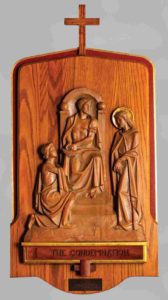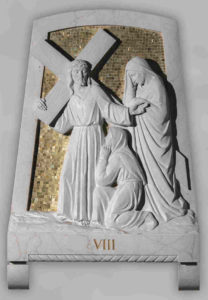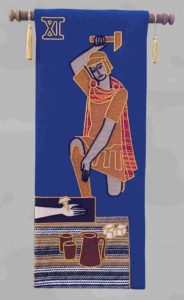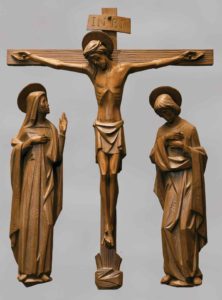
We adore you, O Christ …
At each Station of the Cross, steps along Jesus’s path toward Calvary come to life in the hearts and imaginations of the faithful.
“It is to engage in the mystery of the cross – a physical way through hymn, prayer and genuflecting,” said Redemptorist Father Dennis J. Billy, professor of moral theology and director of spiritual life programs at St. Mary’s Seminary and University in Baltimore. “It engages not only the mind but also the heart. It engages the whole community.”
While the threat of coronavirus has forced the cancellation of public Stations services – from Stations and supper at Holy Family in Davidsonville to the St. Isaac Jogues in Parkville youth group’s annual “Mime Stations” – they remain an inspiration and focus for the faithful.
Some Stations, meanwhile, have stories to tell.

… And we praise you
At the Shrine of St. Anthony in Ellicott City, Our Lady of Perpetual Help parishioners Paul and Beth Szczybor noticed time hadn’t been kind to the outdoor Stations where they prayed every Good Friday.
Beth Szczybor, who died in 2010, made her husband promise to replace them.
“Just before she died, she gave me one of these,” Paul Szczybor wagged his finger, “and said ‘Do something about those Stations.’ ”
He listened, recruiting master carpenter Pete Ogden and some Boy Scouts to install bronze Stations along an asphalt path. They were dedicated in April 2011 in Beth’s honor. During his visits, Paul Szczybor often sees people praying at each Station.
“That’s what Beth would want,” he said.

Jeweled cross of victory
When St. William of York Parish renovated its 1914 church before its centennial, a gold-and-scarlet color scheme was chosen, echoing the colors of the Stations, according to Wayne Hipley, the pastoral associate.
Painted on wood in Venice with gilded halos, they were selected by Catherine Linehan, who sought to memorialize her husband, William. Only their frames needed any refurbishment.
“The paintings were in very good shape,” Hipley said.
In southwest Baltimore, St. Benedict Parish produced a booklet featuring photos of its Stations for its 125th anniversary in 2018, according to Benedictine Father Paschal Morlino, the pastor. The Stations were installed when the church was built in 1932.
“The Stations of the Cross are so beautiful,” he said.

Were you there?
Since ancient times, worshippers, individually and as a group, have been drawn to the actual Via Dolorosa in Jerusalem.
Legend has it that Mary was the first to follow the Way of the Cross after Jesus died, according to Annapolis-based Therese Borchard, who wrote the chapter on Stations of the Cross in the book, “Awake My Soul: Contemporary Catholics on Traditional Devotions.”
She goes on to say that the earliest Christians followed Mary’s example. Among them was a fourth-century woman named Egeria, according to Father Shawn Gould, assistant professor of systematic theology at St. Mary’s Seminary, who published an account of her visit to Calvary and other holy sites.
“It’s a treasure trove of what life was like then,” he said.
Christians were finally able to worship publicly without fear of persecution and many desired to go to Jerusalem and see these special places.
“Not everybody can go to Jerusalem,” Father Gould noted. “How can they have the experience without going there?”
The Franciscans exported the Stations of the Cross as a way of praying on a route similar to the path through Jerusalem, he said.

Let me share with thee his pain
One of the most popular prayers for the Stations was written in 1761 by St. Alphonsus Liguori, founder of the Redemptorists, as part of his parish mission work.
“The Way of the Cross would have been a structure the Redemptorists used to help the people enter into the passion and death,” said Father Billy, the St. Mary’s Seminary professor.
At St. Margaret Parish in Bel Air, lunchtime contemporary Stations in normal times have had a loyal following, said lector Mark Mueller, who has conducted the service for about 15 years.
“People relate to it because it relates to everyday life” he said.
A service written by Redemptorist Father Richard G. Furey focuses on Mary’s reflections as she follows Jesus. Both Our Lady of Mount Carmel in Thurmont and St. Katharine Drexel in Frederick have used those reflections in Lents past.
The beauty of Stations is that they can be prayed privately. With coronavirus restrictions limiting access to churches, outdoor Stations may be an option. In addition to the Shrine of St. Anthony, those at the National Shrine Grotto in Emmitsburg draw many for such private devotions, according to director Dawn Walsh.
“I’m trying to keep the grounds open, so people can come and pray,” she said.
Visit bitly.com/cr-stations for Archbishop Lori’s reflections on the Stations of the Cross.

